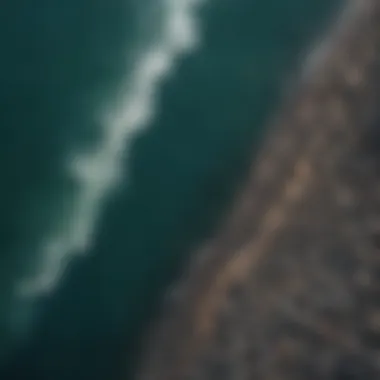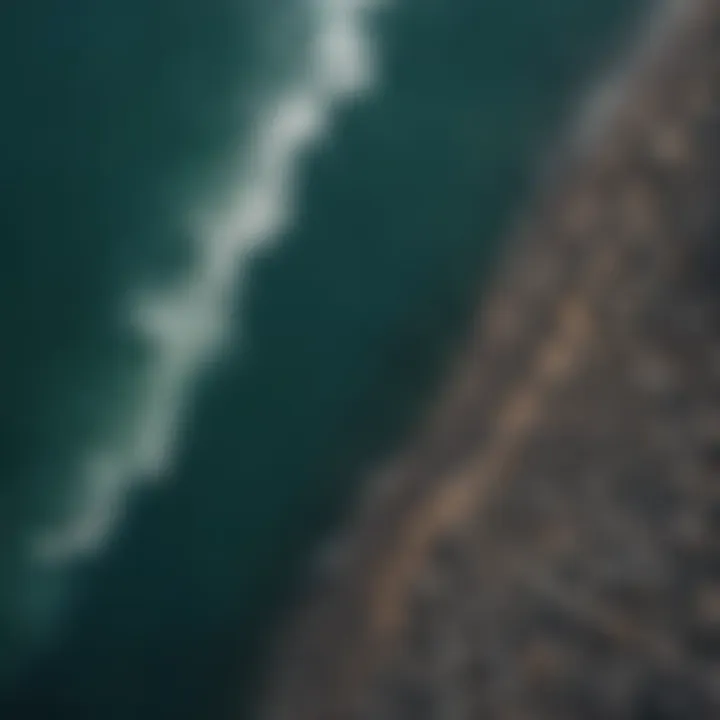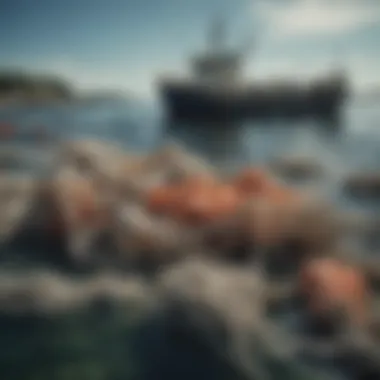Environmental Challenges Facing Our Oceans Today


Intro
The health of our oceans is in a delicate balance, and myriad threats loom on the horizon. We often think of the ocean as a vast, untouchable resource, yet its future hangs by a thread, caught in a web of pollution, climate upheaval, and overexploitation. From the vibrant coral reefs that teem with life to the serene coastal waters that give us recreation, not addressing these environmental problems can lead to catastrophic outcomes, not just for marine biodiversity, but also for the coastal communities that depend on these waters for their livelihoods.
Despite our seeming disconnection from the ocean's depths, the reality is that each wave is intertwined with our daily lives. The decisions we make, whether consciously or subconsciously, have repercussions that stretch far beyond our shores. This piece seeks to disentangle the numerous environmental issues plaguing our oceans, dissecting their origins and exploring viable solutions. As we dive into the causes—pollution from plastics to runoff, climate change altering the intricate temperature and salinity balances, and overfishing pushing species to the brink—the objective is to create a tapestry of understanding.
Marine biodiversity is not just a scientific term; its decline impacts everyone. Take fishermen who depend on healthy fish stocks; their livelihoods are at stake. The cascading effects extend to ecological balance, and ultimately societal well-being. This article aims to equip watersports enthusiasts, adventure seekers, and even policymakers with a clearer picture of what’s happening beneath the surface and why it matters. The idea is to foster a collective sense of responsibility, because every little action counts when it comes to ocean conservation.
Discovering practical techniques, essential gear, and the knowledge to make informed choices is the aim here. This guide isn’t merely to inform; it’s a rallying call for all of us who enjoy the splendor of our oceans. Now, let’s dive deeper.
Preamble to Oceanic Environmental Challenges
The oceans cover more than 70% of the Earth's surface, acting as a crucial component of our planet’s ecosystem. However, they're under siege from various environmental threats that not only endanger marine life but also affect human existence. The introduction of oceanic environmental challenges is essential to comprehend just how crucial it is to monitor and protect these vast waters. Understanding these challenges allows us to better appreciate their role not just in biodiversity preservation but also in global climate stability.
Defining Ocean Health
Ocean health refers to the overall well-being of marine ecosystems, including the physical, chemical, and biological conditions of ocean waters. It’s not simply an abstract concept; it's a critical measure with tangible implications. When we speak of a "healthy ocean," we're considering factors like water quality, biodiversity, productivity, and the ability to support a vast range of life.
Marine health can be gauged by various indicators such as the presence of nutrient pollutants, the levels of plastic waste, and the diversity of species found in any given region. For instance, rich coral reefs often signify healthy ecosystems, while dead zones—areas devoid of life due to excessive nutrients—indicate severe deterioration. Understanding ocean health thus involves a multifaceted approach that includes biological assessments, chemical analyses, and physical measurements. When any one of these aspects falters, the entire system can feel the strain.
Importance of Oceans for Humanity
Oceans are not just a playground for fun activities or scenic beauty; they’re vital to our survival. They produce more than half of the world's oxygen, serve as a major climate regulator, and provide invaluable resources. Many communities, especially those living in coastal regions, rely directly on the ocean for food, employment, and cultural significance.
• Food Supply: The oceans give us incredible culinary delights, from fish to shellfish. These are not optional luxuries; they are essential sources of protein for billions of people.
• Climate Regulation: The oceans play a critical role in maintaining the balance of gases in our atmosphere, absorbing carbon dioxide and helping to regulate global temperature. This function is increasingly under threat due to climate change.
• Economic Stability: Countries with coasts often bolster their economic activities through fisheries and tourism. Coastal communities can thrive on these industries if the marine environment remains healthy.
"Healthy oceans are the world's life support system. If we fail to keep them healthy, we endanger not only oceanic life but our own existence as well."
Thus, comprehending the interconnectedness of ocean health and human well-being is critical. As sports enthusiasts, instructors, and adventure seekers explore our seas, they must recognize their role in advocating for the protection of these invaluable resources. The importance of oceans for humanity is manifold and should inspire action toward sustainable practices for future generations.
Pollution: A Pervasive Threat
Pollution in our oceans acts like an invisible enemy, slinking through the depths and affecting marine life and human health alike. It's a broad topic, composed of numerous layers that interact and intertwine with many aspects of oceanic health. By delving into the sources, types, and consequences of pollution, we can peel back these layers and gain a clearer understanding of how pollution constitutes a formidable threat to our marine environments.
Types of Marine Pollution
Plastic Pollution
Plastic pollution remains a glaring issue in the ocean. Something as seemingly harmless as a plastic bottle can travel through water systems, breaking down into harmful microplastics that invade marine habitats. The sheer volume of plastic produced is staggering, and its durability means this material doesn't just vanish. In this narrative, plastic pollution isn’t just a side note; it is a headline act that underscores the larger story of how human consumption impacts ocean health.
The key characteristic of plastic pollution is its persistence. Unlike organic materials, plastics can linger in the ocean for hundreds of years, causing long-term damage. Because of its ubiquity, it serves as an essential topic in this discussion.
A unique feature of plastic pollution is its ability to absorb harmful chemicals from the water, which can then be ingested by marine life, creating a toxic chain that ultimately reaches human tables. This is a serious disadvantage, particularly when considering seafood safety.
Chemical Contaminants
Chemical contaminants come from a variety of sources, including agricultural runoff and industrial discharge. These often invisible substances, such as heavy metals and pesticides, seep into the ocean and wreak havoc on marine ecosystems. Their contribution to the overall pollution crisis cannot be overstated; they alter phytoplankton growth, affect fish populations, and introduce harmful agents into food webs.
The key characteristic of chemical pollutants is their ability to bioaccumulate, meaning they can concentrate in the bodies of organisms over time. This aspect makes discussions about chemical contaminants particularly urgent.
What sets chemical contaminants apart is their often insidious nature; many are tasteless and odorless, leading to dangerous delays in detection and response. In this article’s context, understanding chemical pollutants gives readers insight into the complex interactions between land and sea.
Noise Pollution
When one thinks of ocean pollution, sounds aren’t the first thing that comes to mind. Yet, noise pollution is a growing concern, disrupting the communication and navigation of marine mammals like whales and dolphins. The clamor from ships, oil drilling, and other activities can have profound effects on their behaviors.
A key characteristic of noise pollution is its ability to interfere with the natural acoustics of marine environments. This is a relevant topic, as many marine species rely on sound for survival, especially in breeding and feeding.
A unique feature of noise pollution is its often overlooked impact on mental health within marine populations. Animals exposed to persistent loud sounds can experience stress, leading to detrimental impacts on their populations—a fact that’s incredibly crucial for anyone invested in marine conservation.
Thermal Pollution
Thermal pollution refers to the alteration of water temperature due to industrial processes, like power generation. These activities can cause hot water to be released into oceans and estuaries, directly impacting local marine ecosystems.
The key characteristic here is the rapid change in temperature that can make it hard for marine organisms to adapt. This can lead to reduction in species diversity, as many fish prefer a narrow temperature range to thrive.
What’s unique about thermal pollution is the indirect effect it has on dissolved oxygen levels in water. Warmer water holds less oxygen, which can lead to hypoxia, creating dead zones where life struggles to exist. Highlighting thermal pollution in this discussion demonstrates how interconnected and complex the web of oceanic threats can truly be.
Sources of Ocean Pollution
Land-Based Sources
A significant chunk of ocean pollution comes straight from land-based sources, such as stormwater runoff that washes fertilizers, pesticides, and sediments into coastal waters. This infiltrates marine habitats and poses risks to both ecosystems and human health.


The key characteristic of land-based sources is their direct link to terrestrial activities. It shows us that what happens on land doesn’t just stop; it flows into our oceans, making it a crucial aspect to focus on.
A unique feature of these sources is their reliance on rainfall, meaning pollution can vary significantly depending on regional weather conditions. While industrial zones might generate excessive pollutants, rural areas can see their own unique challenges, like agricultural runoff. This variability underscores the need for multiple approaches to tackle pollution from different fronts.
Marine-Based Activities
Marine-based activities, from fishing to tourism, also contribute to ocean pollution. Boats can leak fuels and oils, littering the water, while marine construction can alter habitats. These activities are essential in understanding the broader spectrum of pollution sources and their implications.
The key characteristic lies in their economic necessity; many coastal communities rely on these activities for their livelihood. This connection makes marine-based pollution a significant point of discussion in this article.
What’s unique about these sources is the fine line they walk between economic benefits and environmental risk. They’re essential for income and jobs, but they also necessitate diligent management to minimize their environmental footprint, reminding us of the delicate balance necessary for sustainable ocean stewardship.
Shipping and Transportation
Shipping and transportation represent a significant source of pollution in oceans. Tankers can spill oil, while cargo ships release noxious fumes, contributing to both chemical and physical pollution. The scale is immense, as hundreds of thousands of vessels traverse oceans every year.
The key characteristic of shipping pollution is its global scale. Most goods move across oceans, creating a widespread impact. Highlighting this aspect brings attention to how interconnected the world is through commerce—what happens in one part of the world can directly affect ocean health elsewhere.
What’s unique about this pollution source is the difficulties in regulation. Navigating national waters requires careful legal frameworks that can be tough to enforce, making it a prominent and challenging aspect of maritime pollution control efforts.
Consequences of Marine Pollution
Impact on Marine Organisms
Marine pollution has dire effects on organisms that inhabit these waters. From the tiniest plankton to the largest whales, the impacts are felt at all levels of the food chain. Polluted waters can change reproductive success, growth rates, and can even be lethal.
The key characteristic to focus on is the multifaceted impact: pollution doesn’t just affect one species but creates a ripple effect throughout the entire ecosystem. This makes it crucial for understanding the collective challenges marine life faces.
A unique feature is how different species can be affected in varied ways. For example, while some fish may suffer from reproductive issues due to chemical contaminants, others might ingest microplastics that impact their feeding behaviors—both actions pointing to the stark reality of pollution's impact on biodiversity.
Human Health Risks
Human interaction with polluted oceans poses significant health risks, particularly through seafood consumption. Contaminated fish can lead to foodborne illnesses or long-term health issues due to chemical intake, affecting communities reliant on fishing.
The key characteristic is immediate; people consume fish without knowledge of pollution levels in the ocean. As waters become polluted, the risks grow, making it a pressing issue for all stakeholders involved.
What sets the human health risk aspect apart is its immediacy—while damage to marine organisms takes time to understand, impacts on human health can happen directly and alarmingly fast. This taps into a human-centric narrative around oceans, emphasizing that conservation isn’t just about saving fish; it’s about protecting ourselves.
Economic Consequences
Marine pollution doesn’t just affect health and ecosystems; it can hit economic sectors hard too. Fishing, tourism, and recreation all suffer when pollution levels rise. Communities that depend on healthy oceans find their livelihoods at stake.
The key characteristic here is the undeniable relationship between environmental conditions and economic health. An unhealthy ocean translates to fewer fish and desolate beaches, impacting local economies immensely and underscoring the pressing need for action.
A unique feature of this economic consequence is the long-term financial burden created by addressing pollution aftermath. Cleaning efforts, declining fish stocks, and loss of tourism revenue can create a protracted cycle of economic strife. It stresses the interconnected nature of oceanic health and economic vitality, highlighting why pollution is a pervasive issue that must be addressed.
Climate Change and Its Oceanic Implications
The impact of climate change on ocean environments is profound and multi-faceted. Understanding this relationship is crucial not just for marine scientists but for anyone whose actions touch upon the health of our waters. As temperatures rise globally, oceans, which are often considered our planet's heart, respond in ways that can have cascading effects on marine life, ecosystems, and human livelihoods. The increasing severity of climate change's consequences calls for an urgent conversation about adaptation and mitigation strategies that are tailored to address these ocean-specific challenges.
Rising Sea Temperatures
Rising sea temperatures are one of the most visible signs of climate change. As the planet heats up, so do ocean waters, impacting diverse marine life and ecosystems. Fish species migrate towards cooler waters, leading to shifts in biodiversity. Coral reefs, which are highly sensitive to changes in temperature, are particularly affected. When waters become warmer than usual, many corals expel the algae they rely on for energy, resulting in coral bleaching.
- The threat to fisheries: Many fish populations depend on specific temperature ranges. A rise in temperature can alter spawning patterns and reduce fish productivity, impacting food supply for millions.
- Impact on ocean currents: Warmer waters also affect ocean circulation, crucial for regulating climate. Disturbances in currents can lead to extreme weather events.
Ocean Acidification
Ocean acidification stems from increased CO2 levels in the atmosphere, with the ocean absorbing a significant amount of this gas. When CO2 dissolves in seawater, it forms carbonic acid, lowering the pH. This chemical change impacts marine organisms, particularly those with calcium carbonate shells or skeletons, like shellfish and some plankton species.
- Threat to marine food webs: The weakening of shellfish can ripple through ecosystems, affecting the species that depend on them for food, including commercially important fish.
- Coral susceptibility: As with rising temperatures, higher acidity levels make corals more vulnerable to stressors, contributing to further coral reef degradation.
Effects on Marine Habitats
Coral Bleaching
Coral bleaching is a significant consequence of rising sea temperatures and ocean acidification. When stressed by heat or acidity, corals lose their vibrant color due to the expulsion of the algae living within them, leading to a white, bleached appearance. This is not just an aesthetic issue; it represents a critical threat to coral health and, by extension, marine biodiversity.
- Key Characteristic: Coral bleaching is closely tied to the health of reef ecosystems, which rely on the symbiotic relationship between corals and algae. Without algae, corals struggle to survive.
- Implication for Ecosystems: This process diminishes habitats for countless marine species, threatening the biodiversity that maintains the ocean's ecological balance.
Coral reefs are among the most biodiverse ecosystems on Earth, but they are also among the most vulnerable.
Disruption of Ecosystems
Disruption of ecosystems is another grave consequence associated with climate change. Changes in water temperature and chemistry alter predator-prey relationships, nutrient cycles, and overall ecosystem dynamics. These shifts can push certain species to the brink of extinction, while others may thrive under new conditions, often to the detriment of the established balance.
- Unique Feature: Ecosystems are dynamic and constantly adapting, yet rapid changes from climate factors can outpace these adaptations.
- Risks Imposed: This disruption diminishes the natural services ecosystems provide, like water filtration, coastal protection, and carbon sequestration, essential for maintaining ocean health and combating climate change.
The narrative surrounding climate change and its implications on oceans paints a bleak picture but underscores the urgent need for action and awareness. Understanding these challenges can inform better practices not only for those in marine sports and industries but also for everyday individuals aiming to contribute positively to oceanic health.


Overfishing: Depleting Marine Resources
The ocean has long been seen as a boundless resource, teeming with life and capable of providing for countless generations. However, overfishing jeopardizes this delicate balance. The staggering rates at which fish are harvested not only threaten individual fish populations but also impact the entire ocean ecosystem. In this section, we will delve into the causes of overfishing, examine its impacts on fish populations, and explore the long-term consequences for marine ecosystems.
The Causes of Overfishing
Technological Advances
The evolution of fishing technology has certainly transformed the industry. Innovations such as sonar, GPS navigation, and more efficient nets have changed the way fish are caught. While these advancements have increased catch efficiency, they also lead to unsustainable practices. Fishermen often target specific species without considering the long-term health of the stocks. This drive for immediate profit can result in the depletion of entire populations. With the ability to catch more fish than ever before, the implications for marine life are dire.
High Demand for Seafood
With sushi bars popping up on nearly every corner and seafood being hailed as a healthy dining option, the demand for fish continues to rise. People around the globe seek out various types of seafood for both culinary and nutritional benefits. This insatiable appetite poses a significant challenge for maintaining balanced fish populations. The need to satisfy consumers often leads to overexploitation. When combined with the fact that many consumers are unaware of sustainable sourcing practices, it becomes clear how quickly the situation can escalate.
Lack of Regulation
In many regions, fishing regulations are either non-existent or poorly enforced. This negligence permits overfishing to thrive, as fishermen can capture fish without consideration for quotas or seasonal closures designed to help populations regenerate. Moreover, in some areas where regulations do exist, enforcement can be lax, making it easy for illegal fishing to flourish. The absence of strong regulations can create a free-for-all mentality among fishermen, resulting in a race to catch as much as possible, further endangering fish stocks.
Impact on Fish Populations
The ramifications of overfishing on fish populations are far-reaching. As numbers dwindle, the natural predator-prey dynamics within marine ecosystems are altered. Species that depend on certain fish for food may struggle to survive, leading to a ripple effect throughout the food web. Moreover, when key species are removed, the entire ecosystem can collapse, affecting not only marine life but also human activities that depend on healthy oceans. In essence, the decline of fish populations threatens the biodiversity that maintains the ocean's resilience.
Long-term Consequences for Ocean Ecosystems
Overfishing is not just a short-term problem; it has far-reaching implications for ocean ecosystems. As species vanish, previously balanced interactions can become imbalanced, leading to overpopulated species and the decline of others. Coral reefs, crucial biodiversity hotspots, can be negatively affected through the loss of herbivorous fish that maintain their health. Furthermore, the economic impact of declining fish stocks can shake coastal communities to their roots as livelihoods vanish and competition for remaining resources intensifies. Ultimately, overfishing spells trouble not just for fish, but for entire ecosystems and those who rely on them.
"The ocean is a complex web of life, and when one strand is pulled too hard, the entire tapestry risks unraveling."
In summary, overfishing emerges as a primary threat to marine resources, intertwined with socio-economic consequences. Addressing these challenges requires a collaborative effort to implement sustainable fishing practices, enhance regulatory frameworks, and inform consumers about responsible choices.
Marine Biodiversity Loss
Marine biodiversity is like the intricate threads of a vast tapestry, each species contributing to the beauty and balance of ocean ecosystems. Losing biodiversity isn't just about seeing fewer fish or corals; it disrupts the very foundation of marine life. This loss bears serious implications for the health of our oceans and, by extension, our planet. The benefits of maintaining marine biodiversity are numerous, ranging from ecological stability to economic advantages for coastal communities.
The Importance of Biodiversity
Biodiversity in marine environments ensures resilience against changes and stresses. Healthy oceans are home to a diverse range of species, from microscopic plankton to the majestic blue whale. Each organism plays a specific role, contributing to nutrient cycling, food web dynamics, and overall ecosystem health. When biodiversity is robust, ecosystems are more likely to withstand and recover from disturbances, such as climate change or pollution.
The importance of biodiversity transcends ecological benefits. Economically, diverse marine life supports fisheries, tourism, and recreation, which are vital to many coastal communities. For example, regions known for their thriving coral reefs attract significant tourism, bringing jobs and income to local residents. When biodiversity dwindles, these economic lifelines can fray quickly, leaving communities vulnerable.
Threatened Marine Species
The oceans are home to a staggering variety of species, many of which are now threatened, if not endangered. Iconic species like the leatherback sea turtle or the hammerhead shark become symbols of this crisis. Factors contributing to their decline include habitat destruction, overfishing, and pollution. In turn, the loss of these species can trigger a chain reaction, undermining ecosystem functions.
Research reveals that as species face extinction, the total biodiversity of marine ecosystems declines. This isn't just about individual animals; it's about the intricate networks that sustain life underwater. For example, corals, which rely on cleaner water and stable environments, are hugely impacted by rising temperatures and acidification. These threats force them to shrink or collapse, leading to entire reef ecosystems falling apart, and with that loss goes the multitude of creatures that depend on them.
"A healthy marine ecosystem is more than just a collection of different species; it’s about the interactions between them that create a balanced system."
Ecosystem Services at Risk
Ecosystem services provided by marine biodiversity are often undervalued. These include coastal protection, carbon sequestration, and nutrient cycling. Mangroves, for instance, act as natural barriers against storm surges while also providing habitat for various species. When biodiversity diminishes, these crucial services are at risk.
Moreover, the decline in marine species disrupts critical processes, like pollination and seed dispersal, which are essential for maintaining healthy marine habitats. Coral reefs are also vital providers of many ecosystem services. The loss of marine biodiversity threatens food security and livelihoods, particularly for coastal communities heavily reliant on fishing.
Socioeconomic Impacts on Coastal Communities
Coastal communities are often the first to feel the brunt of environmental issues in the ocean. Its not just about the turquoise waters or the white sandy beaches; these regions depend heavily on the ocean for their economic well-being and cultural identity. The delicate balance these communities navigate is profoundly affected by several factors, including pollution, climate change, and overfishing, which directly threaten their livelihoods and way of life.
Dependence on Marine Resources
The connection between coastal communities and the ocean is one built over generations. Many of these communities rely on marine resources for a living. Fishing, tourism, and marine-based businesses provide direct employment to thousands. For instance, consider the small fishing village of Tarpon Springs in Florida. It thrives on its sponge diving industry, where divers harvest sponges for sale. However, when pollution or overfishing occurs, the catch diminishes, and the economic ripple effects can be devastating. Recreational activities like kayaking and diving also serve as significant income streams, drawing tourists who are seeking adventure and connection with nature.
Impact of Marine Pollution on Livelihoods
Marine pollution impacts resources directly, which influences the economy of coastal communities. Oil spills, plastic waste, and chemical runoff can contaminate fishing waters, leading to health advisories and fishing bans. People like the fishermen in the Gulf of Mexico often face uncertain futures during such events. Not only must they abandon their catch, but also the public's perception of their work diminishes. Tourists might hesitate to visit polluted beaches, further straining local businesses reliant on seasonal traffic. As noted by various studies, a single incident of marine pollution can lead to years of recovery, showcasing the transient nature of trust and reliability in these communities' primary income sources.
"In coastal regions, the interplay between the ocean's health and the economy is anything but straightforward. When the ocean suffers, the communities that rely on it pay a steep price."
Adaptation and Resilience Strategies
To mitigate these economic strains, coastal communities are adopting various adaptation and resilience strategies. These can include transitioning to sustainable practices in fishing, such as implementing catch limits or diversifying income through eco-tourism, which promotes marine conservation.
Moreover, local governments and organizations are increasingly engaging in cleanup initiatives and advocating for stronger policies regarding pollution control. Education and awareness campaigns can help locals and visitors alike understand the importance of keeping the oceans clean. Proper waste disposal and minimizing plastic use go a long way in these efforts.
Finally, building partnerships with environmental organizations can pave the path to restoring marine ecosystems, which, in turn, benefits both the ocean and the socioeconomic fabric of these coastal areas. Investing in these strategies not only protects livelihoods but also fosters a sense of community resilience.
In summary, the socioeconomic impacts on coastal communities highlight critical areas of concern that warrant immediate attention and action. By recognizing the depth of this connection, marine sustainability efforts can be better formulated, offering communities a chance not only to survive but truly thrive.
Policy Responses to Ocean Environmental Issues


The ocean is not just a vast body of water; it is a global resource that supports numerous ecosystems and livelihoods. As the threats to ocean health become more pressing, the need for effective policy responses is paramount. Implementing robust policies not only helps mitigate environmental degradation but also fosters sustainable use of marine resources. Our watersports enthusiasts, adventure seekers, and coastal community members can greatly benefit from understanding these policies, as they are crucial in shaping a sustainable future.
International Agreements and Conventions
International cooperation is vital when addressing oceanic environmental problems. Agreement among nations creates a unified front against threats like overfishing, pollution, and climate change. For example, the United Nations Convention on the Law of the Sea (UNCLOS) lays down a legal framework for the use of oceans, providing guidelines for sustainable practices that protect marine habitats. Other international treaties, such as the Convention on Biological Diversity, aim to safeguard marine biodiversity through collaborative action.
These agreements help set standards that countries can follow, fostering compliance and accountability. By participating actively in such conventions, countries can pool resources and share knowledge, driving innovation in marine conservation. Such efforts underscore the importance of collective responsibility to protect ocean health.
National and Local Regulations
While international agreements provide a solid foundation, national and local regulations play a critical role in addressing oceanic challenges at a more granular level. Countries implement their own laws to align with international standards and tailor them to local needs. These regulations can range from establishing marine protected areas to enforcing limits on fishing quotas.
In many coastal regions, community-led initiatives have emerged, such as no-take zones, where fishing is prohibited to allow ecosystems to recover. Additionally, local regulations often include specific practices in coastal management to combat erosion and habitat destruction.
- Enforcement is key: Without strict enforcement, even the best regulations can fall flat.
- Stakeholder engagement: Involving local communities fosters a sense of ownership and responsibility towards marine conservation.
These localized efforts not only preserve marine life but also enhance community resilience by securing the livelihoods of those who rely on these ecosystems.
Role of Advocacy and Activism
Grassroots movements and advocacy groups have become critical players in the fight for ocean conservation. These organizations serve as watchdogs, holding governments and corporations accountable. They educate people on ocean issues, rallying public support and creating an informed audience that demands action.
Advocacy is particularly impactful for situations where policy is lacking. By raising awareness about scientific findings, activists can generate buzz and pressure policymakers into action. For instance, campaigns to reduce plastic usage have sparked significant changes worldwide.
"We need to remember that every small action matters. Advocacy starts at home and spreads far."
The synergy between legislation and grassroots activism creates a powerful force for change. Those engaged in watersports and coastal tourism can support local initiatives, promoting practices that protect their playgrounds.
Innovative Solutions and Technologies
The ever-increasing environmental challenges facing our oceans underscore the urgent need for innovative solutions and technologies. Addressing issues such as pollution, overfishing, and climate change requires a multi-faceted approach that integrates modern advancements to promote sustainability and conservation. The importance of these solutions cannot be overstated, as they hold the key to nurturing ocean ecosystems and ensuring the well-being of coastal communities.
Marine Conservation Technologies
Marine conservation technologies are advancing at a rapid pace, providing tools essential for protecting our oceans. From satellite imaging to underwater drones, these innovations enhance our ability to monitor marine environments effectively.
- Remote Sensing: Techniques allow scientists to observe vast areas of ocean without disturbing wildlife. This helps in identifying pollution hotspots and detecting illegal fishing activities.
- Artificial Intelligence: AI systems analyze massive amounts of data, helping to predict trends and manage fish populations. For instance, AI is used to track fish movements and assess their habitats, informing better fishing regulations.
- Bioremediation: Utilizing micro-organisms can naturally clean polluted water, breaking down harmful substances in a harmless manner. This is particularly important in areas heavily affected by oil spills or chemical waste.
These technologies not only provide actionable insights but also foster a collaborative approach among researchers, policymakers, and the public. By employing these advanced methods, stakeholders in marine conservation can better address the challenges at hand.
Sustainable Fishing Practices
Sustainable fishing practices are critical in reducing the pressure on marine life. The goal here is to maintain fish stocks while minimizing the environmental impacts associated with fishing.
- Selective Fishing Gear: Use of gear designed to reduce bycatch, such as circle hooks or escape panels in nets, allows for the survival of non-target species.
- Catch Shares: A management system that allocates a specific percentage of the total allowable catch to individuals or groups, encouraging responsible fishing behaviors and better resource management.
- Closed Seasons: Implementing periods when fishing is prohibited enables fish populations to recover from overexploitation. It’s akin to giving nature a breather to rebuild its resources.
These practices ensure that fishing can be a long-term viable activity while promoting biodiversity and health within our oceans. It’s not just about taking, but also about giving back to the sea.
Community Initiatives and Education
Empowering local communities through education and initiatives plays a crucial role in ocean conservation. Those living near coastal regions have firsthand knowledge and experience that can significantly contribute to tackling environmental problems.
- Community-Led Conservation: Local groups often implement their own rules and management practices, which can be more effective than top-down approaches. By valuing indigenous knowledge, communities can create sustainable solutions tailored to their unique environments.
- Educational Programs: Schools and organizations are developing curricula focused on ocean literacy, where people learn not only about the ecosystems but also about the human impact on the ocean.
- Volunteer Opportunities: Engaging volunteers in beach cleanups or restoration projects fosters a sense of ownership and responsibility towards marine environments, crucial for long-term protection efforts.
"The change for a healthier ocean starts at the grassroots level, as communities unite, empowered by knowledge and action."
By fostering a culture of stewardship and encouraging community participation, innovative solutions can take root, leading to a more sustainable future for our oceans.
Closure: The Path Forward
As we contemplate the multitude of environmental challenges facing our oceans, there is an increasing urgency to address these pressing issues. This article has elaborated on critical factors like pollution, climate change, and overfishing, each contributing to the degradation of oceanic health. Understanding the complexities of these problems is the first step in fostering action and advocacy. Simply acknowledging these environmental issues, however, is not enough.
As ocean health deteriorates, it directly affects marine biodiversity and disrupts the socioeconomic fabric of coastal communities. The intricate balance of our oceans is at stake, and this balance is essential not only for marine life but for humanity as a whole. The consequences of inaction could see us grappling with the loss of vital marine resources and the collapse of ecosystems that support countless species, including us.
"Oceans are the lifeblood of our planet; without their health, our future is uncertain."
In light of this, collective efforts towards ocean conservation become imperative. The path forward isn’t merely about reacting to problems as they arise, but proactively creating solutions that encompass sustainable practices, research, and public engagement. Initiatives at local, national, and international levels must align to ensure that ocean health is prioritized.
The Urgency of Ocean Conservation
The urgency for ocean conservation cannot be overstated. As we face rising sea temperatures and escalating pollution, the time to act is now. Each year, more plastic enters the oceans, while marine habitats are destroyed at alarming rates. Coral reefs—often dubbed the rainforests of the sea—are disappearing, with predictions estimating a significant loss in biodiversity in the coming decades if current trends continue.
When considering the stakes, it’s vital to recognize that the ocean’s health directly correlates with our well-being. As the backbone of global climate regulation, the oceans absorb a significant portion of carbon emissions and modulate weather patterns. If we do not prioritize their conservation, we risk exacerbating climate change effects that already threaten human life.
Furthermore, neglected oceans will harm local fisheries and tourism, impacting livelihoods for millions worldwide. Therefore, policymakers must prioritize marine protection and enforce sustainable fishing regulations to avert this impending crisis.
Call to Action for Watersports Enthusiasts
Watersports enthusiasts play a crucial role in ocean conservation efforts. As individuals who cherish ocean-based activities, they have a unique platform to influence positive change. Whether surfing, sailing, or diving, these communities can elevate awareness and champion sustainable practices.
Embrace the following actions:
- Advocate for Cleanups: Participate in or organize beach cleanups. Every small effort counts towards reducing pollution.
- Practice Sustainable Sports: Use eco-friendly equipment and promote sustainable tourism. Opt for local and responsible operators who share your values.
- Spread the Word: Use platforms like Facebook and Reddit to share information about ocean conservation. Your voice can inspire others and foster a community dedicated to this cause.
- Engage in Local Policies: Attend town hall meetings or get involved with local environmental groups focused on ocean health.
Through these approaches, watersports enthusiasts can help cultivate a culture of conservation. By promoting respect for ocean ecosystems during recreational activities, they can inspire others to join the movement. Together, we can forge a path forward that ensures the rich tapestry of marine life thrives for generations to come.







